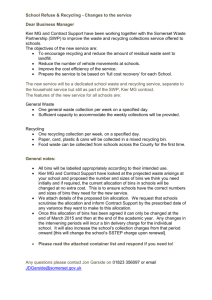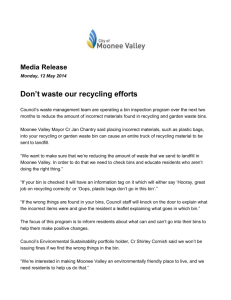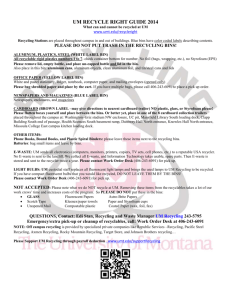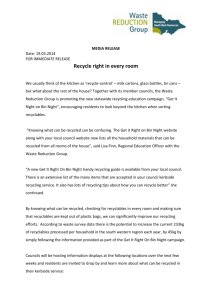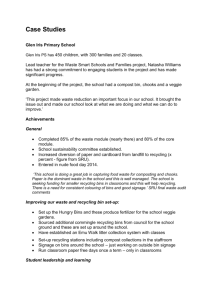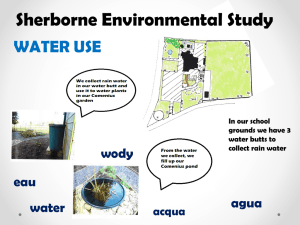Research Action Plan
advertisement
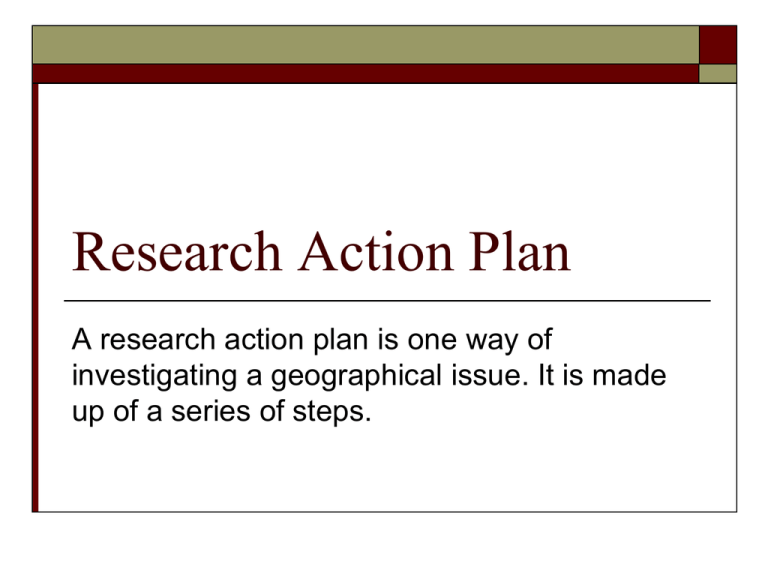
Research Action Plan A research action plan is one way of investigating a geographical issue. It is made up of a series of steps. Steps 1in a research action plan Aim Identify the aim or purpose of the study. Within the aim you need to identify the area that you will study. Examples of aims Too broad: To research waste management in New South Wales Too specific: To find the volume of garbage collected this week in Wattle Street Too complex: To compare garbage collection, recycling and waste disposal in rural areas with those in urban areas Good: To investigate recycling at Green High School Step 2 Questions Generate a number of focus questions to be addressed by the investigation. You are breaking down the overall aim into manageable sections. The questions must relate to the overall aim of the fieldwork or investigation. Example of suitable questions Aim: To investigate recycling at Green High School Questions that could be used 1 Which materials are recycled? 2 How are materials collected for recycling? 3 How much material is recycled? 4 How often are recycling bins emptied? 5 What materials in the main waste stream could be recycled? 6 Which members of the school recycle? 7 Where is the material taken for recycling? 8 How could recycling be improved? Step 3 Data Decide what primary and secondary data is needed to answer the questions. There are two types of data: primary and secondary. Primary data is data that is collected and processed by you. Secondary data is data that has been collected and processed by someone else. Examples of data Question: How are materials collected for recycling? Primary data that could be collected includes: • photographs of each type of recycling bin or collection method used in the school • the number of each type of collection method • the location of each bin or method. Secondary data that could be collected includes: • information from the school about how the material is collected • collection procedures from a waste management company. Step 4 Techniques Identify the techniques that will be used to collect the data. Primary techniques: field sketches, photos, collecting samples, surveying, interviewing. Secondary techniques: collect newspaper articles, internet research, books, journals. Primary • Field sketching, photography, making a video • Mapping, constructing transects • Counting, timing, tallying, measuring • Collecting samples, water and soil testing • Surveying, interviewing • Requesting answers to specific questions or gathering opinions from individuals by letter, email or phone Secondary Internet research • Collecting media articles • Recording radio or TV broadcasts • Requesting official data by letter, email or phone from organisations such as councils, NRMA, ABS • Using books, journals or other printed material to find data Step 5 Collecting primary and secondary data. Example of data collection technique Primary data: The location of each bin or collection method. Technique: Mapping Consider: Are the bins always in the same place? Do you need to map the locations for wet and dry days, or for normal school days and special event days? Consider: Are you going to draw your own base map or make a copy of one? Example of collecting data Technique: Mapping Collection: Using photocopies of the school plan, record the location of recycling bins on a normal school day and on the day of the athletics carnival. Mark each bin with a cross—red for paper, blue for plastic bottles and yellow for cans. 6. Processing Processing and analysing the data collected. This involves creating tables, graphs, annotated maps and /or photographs. This makes the information easy to see. Edit secondary data and produce transcripts or summaries of interviews. As you process the data you must analyse the results by looking for answers to your questions, make relationships clear and consider any implications of your findings. Example of processing and analysing data Data collected: Maps of bin locations in three different occasions. Processing and analysing: Complete the maps with key, scale, north point and headings, indicating the type of day data collected, for example ‘Distribution of bins for the athletics carnival.’ You may choose to mount each map on card or scan them into a software program depending on the style of your presentation. Add annotations about the observed distribution on each occasion, for example a note pointing out the increased number of bins near the oval for the athletics carnival. To analyse this data consider if the bins are moved to cater for different events, and if they are, whether this causes a problem elsewhere, or if they are not, whether they should be moved. Look to see if the data about bin location is related to any of your other data. Step 7 Presenting Select presentation methods to communicate your findings effectively Written report Report needs to make clear : statement of aim, focus questions, location of study. You should describe what the data shows and answer the focus questions. Step 8 Action Propose individual or group action in response to the research findings and where appropriate take the action.
